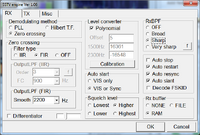| Denoised SSTV picture | |
|---|---|
 Denoised version of a SSTV image distorted by a Xhosa chant added to the signal. | |
|
SSTV image denoiser |
|
Slow-scan television (SSTV) is a picture transmission method used mainly by amateur radio operators, to transmit and receive static pictures via radio in monochrome or color.
A technical term for SSTV is narrowband television. Broadcast television requires 6 MHz wide channels, because it transmits 25 or 30 picture frames per second (in the NTSC, PAL or SECAM color systems), but SSTV usually only takes up to a maximum of 3 kHz of bandwidth. It is a much slower method of still picture transmission, usually taking from about eight seconds to a couple of minutes, depending on the mode used, to transmit one image frame.
Since SSTV systems operate on voice frequencies, amateurs use it on shortwave (also known as HF by amateur radio operators), VHF and UHF radio.
SSTV in the transmissions[]
Many of the transmissions include SSTV pictures. The mode used is always Scottie1.
Sometimes the SSTV signal is distracted by songs or other sounds which produces a blurry and distorted picture.
How to receive SSTV pictures with your PC[]
Setting up the Soundcard[]

How to Enable Stereo Mix in Windows 7
Example for Windows 7
First set up your soundcard to use the Stereo Mix or "What you hear" setting as default recording device.
To do that, follow the instructions in the video and enable Stereo Mix as the default recording device.
To do that in win XP go to Contrrol Panel, Sound and Audio devices, tab Audio, and select your soundcard in the second field named sound recording. http://prntscr.com/qsjnd
Setting up RX-SSTV[]

My setup
Your first step should be to go to Setup -> RX-SSTV in the main Window to set up how RX-SSTV handles the pictures.

My settings for Step 2
Second step is to go to Setup -> SSTV Engine and Calibrate your sound card. To do that, you simply press the Calibration button in the Level converter section.
Third step is to find the DSP section in the main Window and make sure AFC and BPF are enabled. LMS should only be used if the image is very noisy.
Receiving pictures[]
Now this should be the easiest part. You just have to listen to the transmission while RX-SSTV is running. When the SSTV transmission starts you should see the progress in the television window of RX-SSTV.
After the picture is received you can save it with the small save button underneath the picture.
To check if your settings are correct you can use this yourube video:
http://www.youtube.com/watch?v=iEV-F4FOGwQ
or this spreaker transmission:
http://www.spreaker.com/user/4575714/fifty_two
Tools[]
You can find all the tools used above, in the Tools section